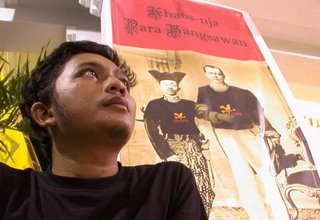
Kuncarsono, Publised by The Jakarta Post on Monday, October 30, 2006
Historical documents can be preserved in many ways, such as by keeping them in display cabinets, reinscribing them or framing them.
However, Kuncarsono Prasetyo has his own distinct way of preserving them -- printing the old texts on T-shirts.
"I want people to know that there's a uniqueness in the old texts, and one of the ways to preserve them is to print them on T-shirts," Kuncarsono, fondly called Kuncar, told The Jakarta Post.
His attraction for the old texts started when he worked as a reporter with a local publication. The former student activist was then writing about historical documents in East Java. He noticed that each document had its own character.
"I'm surprised that not many people are aware of these historical works -- such as old advertisements, stamps and coins, which have their own distinct character -- they are only stored in cabinets at the library," he said.
He said that the old advertisements and stamps, for example were well designed, through which they have now transformed into various styles.
He said that many people were unfamiliar with the faces of the country's historical figures.
"Few people in East Java recognize the faces of Javanese rulers, or even regents who played a vital role in the country's history," he said.
Not to mention local figures, who are known to people only by their names, such as Cak Durasim, Sarip Tambak Yoso, Besoet and Sakerah.
"People know overseas figures like Che Guavara and Malcolm X better, despite the fact that East Java figures like Cak Durasim, Sarip Tambak Yoso, Besoet and Sakerah, without doubt were also revolutionary figures," said Kuncar.
Cak Durasim, for example was known for his fiery poems which aroused the fighting spirit of freedom fighters against the Japanese occupying forces. He was later arrested and banished by the Japanese forces, but had successfully ignited the spirit of the Arek Surabaya freedom fighters at that time.
With Rp 10 million (US$1,100) as capital, Kuncar, together with a local artist, Junaedi, started printing the historical texts on T-shirts. Although the business was a gamble, the move was deemed timely due to the current retro and vintage fashion trend.
"People say the trend now is anything that is old, so there's no harm trying to familiarize the public with history and at the same time sell T-shirts," he quipped.
Kuncar chose old advertisements as his initial project. The ads have their own distinctive character, especially in the use of the Indonesian language, such as an ad about a rabies drug published in the Tjahaja Siang daily in 1869, that is cited as the oldest ad in the book Indonesian Advertising History published by the Association of Indonesian Advertising Agencies (PPPI). The other ad is on the Bintang Timoer Band printed in the Keng Po newspaper in 1932 and the Surabaya municipality ad printed in the Alijoem daily in 1936.
"The newspapers which had published the ads don't exist anymore, but that's what makes it more interesting," said Kuncar.
He plans to print T-shirts of old stamps and historical portraits later. "I will produce other themes when I've collected from the sales of the ad T-shirts," said Kuncar.
Kuncar allows anyone to copy his T-shirts.
"Please, do duplicate my T-shirts. I won't sue anyone because every Indonesian citizen has the right to obtain historical information," he said.







No comments:
Post a Comment